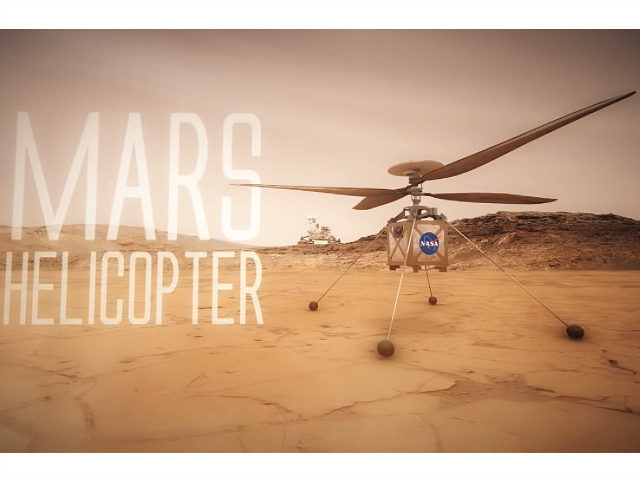NASA’s aircraft is roughly the size of a softball and weighs less than four pounds. It will make five autonomous flights above the surface of Mars in 2021.
The miniature aircraft will spin its rotors at about ten times the speed of a terrestrial one, due to the extremely low density of Mars’ atmosphere — only about one percent of Earth’s. JPL Mars Helicopter Project Manager MiMi Aung explained that “the altitude record for a helicopter flying here on Earth is about 40,000 feet [12,000 meters],” and “when our helicopter is on the Martian surface, it’s already at the Earth equivalent of 100,000 feet [30,000 m] up.” Therefore, designers “had to scrutinize everything, make it as light as possible while being as strong and as powerful as it can possibly be.”
In an official statement posted to the National Aeronautics and Space Administration website, NASA Administrator Jim Bridenstine said, “NASA has a proud history of firsts. The idea of a helicopter flying the skies of another planet is thrilling. The Mars Helicopter holds much promise for our future science, discovery and exploration missions to Mars.”
Texas Representative John Culberson praised the effort. “It’s fitting that the United States of America is the first nation in history to fly the first heavier-than-air craft on another world,” Culberson said. “This exciting and visionary achievement will inspire young people all over the United States to become scientists and engineers, paving the way for even greater discoveries in the future.”
The craft will launch onboard the United Launch Alliance’s Atlas V rocket from Cape Canaveral Air Force Station in Florida in July 2020 and is expected to arrive on Mars in February 2021. Because of its immense distance — Earth will be several minutes away, traveling at the speed of light — Aung said that direct control will be impossible. Instead, the craft will have “an autonomous capability that will be able to receive and interpret commands from the ground, and then fly the mission on its own.”
NASA Science Mission Directorate Associate Administrator Thomas Zurbuchen said that the project “exemplifies a successful marriage of science and technology innovation and is a unique opportunity to advance Mars exploration for the future.”
“After the Wright Brothers proved 117 years ago that powered, sustained, and controlled flight was possible here on Earth,” he said, “another group of American pioneers may prove the same can be done on another world.”

COMMENTS
Please let us know if you're having issues with commenting.